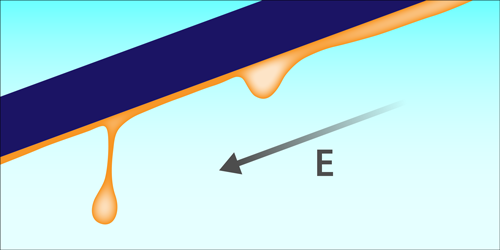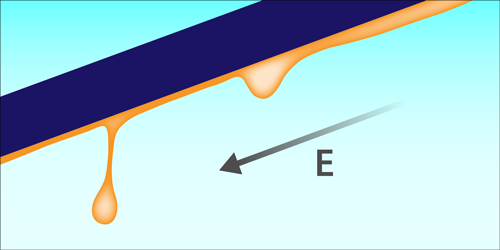No-Drip Films
If you’ve painted a ceiling, you know the annoyance of drips: an initially smooth coat of paint collects in spots that dribble onto the floor. The drips come from a gravity-driven instability in the paint, which physicists have modeled for various liquids and surface tilts. Now Ruben Tomlin of Imperial College London and colleagues have added an electric field into the mix. Their mathematical modeling and simulations show that a strong enough field could stop the drips, an effect that might be used for thin-film cooling or to make uniform coatings in precision manufacturing.
The team’s starting point is a flat slab coated on its underside with a viscous dielectric liquid like oil. In 2015, researchers studied such a setup by tilting the slab and letting the liquid run, finding they could predict the tilt angles at which drips would occur. The Imperial team approaches this problem anew. They derived a set of equations for the film’s surface contour that incorporate not only surface tension and gravity, as in the 2015 study, but also the effect of an electric field applied parallel to the substrate. This field introduces stresses at the film’s surface, which have a stabilizing effect akin to that of surface tension.
Based on their equations, they determined that drips appear roughly when the liquid surface transitions from being “convectively” unstable (in which a disturbance in the liquid ripples away) to being “absolutely” unstable (in which the disturbance remains localized). The researchers predicted that a relatively high field strength would be needed to prevent drips for a 2.5-mm-thick film tilted to 60° degrees below horizontal. But they think lower values might suffice in other cases that are of technological interest.
This research is published in Physical Review Fluids.
–Jessica Thomas
Jessica Thomas is the Editor of Physics.





